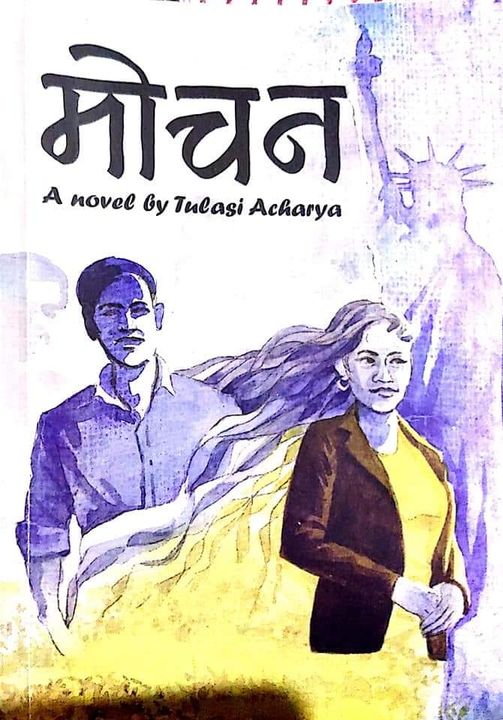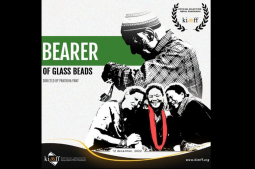
A rising poet cum novelist in Nepali literary arena Dr Tulasi Acharya's novel "Mochan" is the talk of town. “Mochan” is Acharya’s first novel in the Nepali language, and it has already grabbed the reader’s attention. The novel is a bundle of the topics that deal with love, hate,romance, fantasy, significance of sex in a married life, endurance and patience, hardships, relationships, abuse in relationship, perceptions of life, and conflicts and confusions.
In the novel, Acharya gives newness to the content with the book’s title itself "Mochan." The title carries a unique metaphor to reflect on the emancipation of the character from the bondage of life for the sake of happiness. One can break the citadel of social walls if married life prevents him/her from the achievement of joy and happiness. However, this novel is even more than that.
In the way the novel addresses the readers reflects the author’s craftsmanship in the construction of the novel. The technique used in the novel makes the reader continue to read until finished. There are some other techniques the author uses, such as flashbacks. The protagonist Jeevan flies, flapping the wings of nostalgia while he is on a plane or in the bus. The hook of the novel is the tension, the conflict of the narrator within himself and other female characters when he cannot decide who could be the right life partner in his life until he visits Tapoban, a quiet and meditative place in Nagarjun, Kathmandu, and, finally, he becomes enlightened.
The strength of the novel is the writer's capability to carry the reader with the narrator. From the very beginning,the reader forgets whether he is reading the author’s life or the life of the character Jeevan in the novel. The way it is described makes the novel more than real. The description of the sequential events and the consequences are so real that any reader can make a lot of associations.
The protagonist Jeevan is so kind and has so many emotions that he cannot help loving his first wife Aasma even if his wife mistreats him. The way Aasma is projected in the beginning makes the reader hate her, but when she starts sending emails to Jeevan with extreme love appeals, the reader cannot help sympathizing with Aasma for her humane side that Jeevan never found in her before. This is the author’s cleverness not to project Aasma completely into a bad girl. The novel shows that the relationships are made not because of only good people and broken because of bad people; it is because of the things they fail to find in common- that is a brilliant lesson a reader might learn.
In a series of Aashma’s emails, I started to love her.This is the power of this novel to increase a palpitation of the reader’s heart. Also, even if the major character of the novel is Jeevan, two other female characters Ashma and Anamika seem to be equally major characters. Jeevan as a narrator reflects on the role of women and their capability, strengths, and freedom that, I think, hardly any novel in Nepali literature has explored.
While discussing the strengths, there are also some weaknesses that are visible in the novel. The author fails to provide the right words for certain people. The author uses the words in the novel, such as “Khalaashi" instead of bus staff or a helper, or "Apaangha” instead of “a person with a disability.” The author could have avoided those derogatory terms. Since the narrator himself is a very educated person, he could have carefully used those words. Without being careful, such words might martheir self-esteem.
Similarly, another weakness of the novel is to fail to explore the root cause of the problem. However, the author has given some hints through dialogues and tensions.
Aashma driven by materialistic viewpoints and Jeevan driven by goal-oriented viewpoints are the main causes of their difficult relationships. Materialistic people rarely feel love, sympathy because they live for today, not for tomorrow.Everything they see or do try to materialize. They see what is right in front of them and only in a concrete format but can't see what is inside his/her mind,heart, and thoughts. On the other hand, a person like Jeevan gives less priority to the material world. This is the problem the whole novel revolves around.
Nowadays we have different relationships, such as husband and wife, lover and beloved, friends and friends based on castes or financial status or other physical conditions or education. The moral of this novel is now those bases cannot tell whether the relationship lasts or not. There are a million other reasons that are invisible for the relationship to sustain. I think this is another beautiful and most powerful novel in Nepali literature that shows that a brawl between husband and wife is not merely a fire of haystack as a Nepali storywriter Guru Prasad Mainali pointed out in his story “Logne Swasniko Jhagada Paralako Aago”, but it is way more than that. This is a well-researched novel, and I am sure it will win the hearts of many readers.
.






Leave A Comment